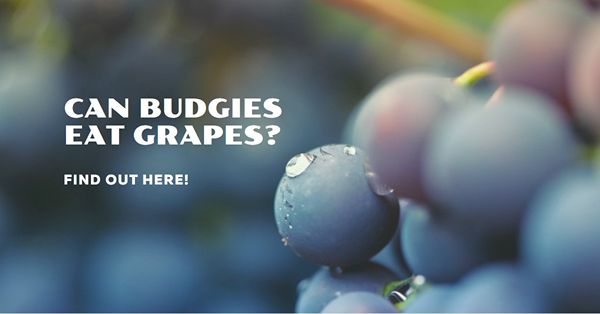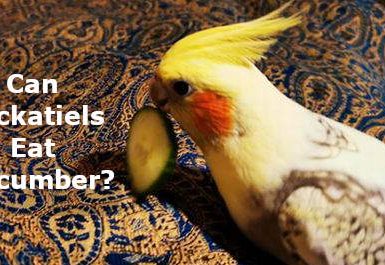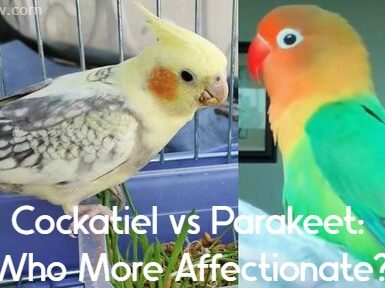
Is it possible to offer grapes to budgies: a table for house birds
Feeding budgies is an important issue for those who are concerned about their feathered companions and want to assure a real table. This is because the right table is the condition of the well and the bird’s life. An issue that concerns many parrot owners is the possibility of providing grapes for their roommates.
Grapes are a tasty and necessary product, often on the human menu. But must grapes be offered to birds? Is the fruit too sweet and too acidic for the wavy parrot?
In this article we will see if grapes can be offered to budgies and if the presence of bird wells has that effect. We will also talk about other foods that can and must be offered in grasperdies in a family context to ensure a real and varied diet.
Basic Foods for Grass Parakeets
- The basis of the bird’s diet should consist of grain foods, including seeds of all kinds of grains.
- Birds should also get many fruits and vegetables, such as apples, peaches, carrots, and cabbage.
- Make sure the bird’s food is jolly and in small quantities.
- More importantly, the bird should have access to fresh water, not contaminated water, which needs to be refreshed daily.
Foods that can be fed to budgies
- Grains of all kinds, including wheat, oats, rye, buckwheat, etc.
- Sunflower and sesame seeds.
- Fruits and berries – apples, pears, kiwi, grapes, raspberries, currants.
- Vegetables – carrots, cabbage, broccoli, cucumbers.
- Green vegetables – parsley, spinach, lettuce, carrot leaves.
- Eggs, cooked or stirred.
Foods not permitted to be served with budgies
- Chocolate and other foods with caffeine and theobromine because they are considered toxic to birds.
- Wet potatoes containing solanine, a toxic substance for birds.
- Foods like sugar and sugars because they are not natural for budgies.
- Salted and fried foods that have every chance to destroy the bird’s digestive system.
- Spices and peppers.
- Alcoholic beverages and tobacco.
Nutritional value of grapes
Grapes are one of the rare delicacies based on their healthy food details. Grape berries contain numerous essential nutrients, including
– Vitamins: C, K, B1, B2, B3, B6.
– Minerals: potassium, calcium, phosphorus, iron, copper, and manganese.
– Antioxidants, fight harmful free radicals in the body.
– Polyphenols and flavonoids, which can help cells defend against damage and disease.
All of the aforementioned nutrients within grapes contribute to the normal functioning of the body, improve skin conditions, strengthen the immune system, and regulate blood cholesterol. However, it must be taken into consideration that grapes are not considered a primary source for birds and should not be fed frequently and in large quantities.
Is it safe to feed grapes to birds?
Grapes are an acid fruit and therefore may not be fed to birds. This can cause digestive problems and may lead to stomach complaints and diarrhea. Additionally, grape seeds can hide the bird’s defecation gutters and cause death.
If you decide to feed grapes to birds, choose only ripe, pitless grapes. However, grapes are rarely offered in large quantities.
Instead of grapes, it is advisable to offer fruit to budgies such as apples, pears, bananas, and black apple berries.
How to serve grapes correctly?
1 Select high quality grapes. Before offering grapes to birds, make sure they are spicy and undamaged. Rather, choose ripe and tasty grapes over others.
2. wash the grapes before serving. Grapes can contain pesticides and other toxins, so they should be washed well before serving to budgies.
3. offer grapes in portions. Grapes do not need to form the basis of the bird’s menu, so it is recommended that a limited number of grapes be offered. It is recommended that no more than two berries per bird per day be offered.
4. Remove seeds from berries. Remove the seeds from the grapes before serving as they may not be safe for the birds. 5.
5. watch how the birds react. If you have never fed grapes to birds, observe how they react to them. If you find signs of allergies or unusual behavior in the bird, consult a grape hung veterinarian immediately.
Basic Calories in the Wavy Parrot Menu
Protein is considered an important part of the wavy parrot diet and contains all the amino acids needed to keep the bird removed and healthy. Protein can come from all kinds of sources, including eggs, fish, and beef.
Carbohydrates are an important source of energy for wagtails. Birds obtain carbohydrates from fruits, vegetables, and grains such as corn and oats.
Fats produce hormones, keep skin healthy, and are essential to the bird’s nervous system. Sources of fat are seeds, nuts, and fish oil.
Vitamins and minerals are essential for the parrot’s bodily functions. Vitamins are available from fruits, vegetables, lush greens, stones, sand, and minerals from all types of feed additives.
Water plays an important role in the life of the parakeet and is critical for preserving all vital bodily functions. That is why sufficient water must always be available.
What types of food are more relevant on a bird’s menu?
Grain seeds are the most famous food for budgies. Cotton seeds, millet, sunflower, oats, barley, and canary seeds are essential on the menu. It is important to remember that providing only seeds is not enough; different seeds must be mixed.
Fruits and vegetables are again an important part of the menu. They provide vitamins and minerals to the birds. Apples, pears, figs, peaches, and other seasonal fruits can be served as fruits. Vegetables should be served raw and grated. Carrots, cucumbers, squash, and zucchini are excellent.
Chicken eggs are the most important protein. It should be served raw, perhaps in the form of egg noodles or egg mips. Eggs should be included on the menu at least once or twice a week.
Green foods are herbs and plants that contain large amounts of fiber. They can promote digestion and better intestinal tract function in birds. Wheatgrass, sorrel, nettles, lettuce, and other green vegetables and herbs are excellent.
Mineral Supplements – Lime, shells, eggshells, and other mineral supplements can be added to poultry menus. They provide the amount of calcium and other micronutrients needed by the bird’s body.
Water is the most important part of the poultry menu. A bird should drink the same amount of water per day as its weight. Remember to guarantee access to normal, uncontaminated water throughout the day.
Risk of Malnutrition
Fluffy parrots are considered a rarity in the wild and their diet can be challenging. On an unhealthy diet, birds must deal with all kinds of health problems, including obesity, food allergies, and severe disease.
The most common malnutrition in budgies is overeating of fats and carbohydrates leading to overweight. Obesity can lead to almost any other health problem, including cardiovascular disease, diabetes, and digestive problems.
Food allergies can lead to different risks of malnutrition. Birds have every chance to develop allergies to certain foods and every chance to develop strong itching and skin suggestions. Some foods still have the potential to cause breathing difficulties, so only foods that have been properly researched for safety should be fed.
Finally, the wrong diet can lead to serious illness. Deficiency or excess calories of vitamins and minerals can lead to serious health problems later on. That is why it is important to feed birds a good balanced food with all the important ingredients.
Which diseases can cause wrong diet ?
Gluttony. Parrots like a strong and varied diet. If you give them too much food they may overeat themselves and become obese. This increases their risk of developing serious diseases such as cardiovascular disease and diabetes.
Vitamin and Mineral Disorders. If your bird’s menu shows deficiencies in key nutrients, this can have serious consequences. For example, a vitamin A deficiency could lead to facial problems, while a calcium deficiency could lead to bone problems.
Gastrointestinal disorders. Inadequate food can lead to the development of gastric and intestinal diseases in birds. For example, feeding very large amounts of seed can lead to indigestion and cause constipation and diarrhea.
Poisoning and Poisoning. Some foods may be unsafe for parrots and cause intestinal infections and poisoning. For example, chocolate, onions, alcohol, and smoking products should be avoided whenever possible.
To prevent these problems, a good menu should be created and the quantity and quality of food fed to the birds should be monitored.
Compile a proper menu for budgies
It is important to know that the diet of a wavy parrot must be balanced and varied to maintain its well and long serving life.
Which foods should be included in the diet?
The wavy parrot’s supply varies and should consist of the appropriate categories.
– Main Food: This is a mixture of seeds including oats, poppy, canary seed, millet, buckwheat, and sunflower.
– Fruits and Berries: Absorbing green vegetables, fruits, and berries into the menu will help the birds get the vitamins and minerals they need. Grapes can still be offered, but in smaller quantities.
– Green vegetables: lettuce, sorrel, and other green plants are still good food sources.
– Supplements: Eimassa, low fat quark, vegetable pieces (carrots, zucchini, broccoli) can be offered.
– Supplements: Calcium can be administered and special vitamin-mineral supplements for clean beaks. Drinking water must be impossible and fresh.
Taking into account all the foods mentioned above, the menu should be balanced, taking into account personal characteristics, age, energy and well being.
How should meals be properly balanced?
To ensure that your paraquito has a healthy and enjoyable time, you must balance his menu. This can be arranged by following certain rules and tips
– Food options: you can feed your paraquito both dry and wet food. However, remember that the menu should consist of crunchy fruits and vegetables.
– Nutrition: do not overfeed the bird, as excess fat can be detrimental to health. Determine the amount of food the paraquito needs and adhere to it.
– Assume Variety: Your bird should not only receive a significant amount of food, but should also receive a varied diet. Fruits, vegetables, and grains of all kinds can be offered.
– Pay attention to water: untouched water is important for parakeets; change water at least two to three times a day and do not leave it in the drinking bowl for too long.
Remember that a good diet is state of the art for your bird’s well. When choosing a mug diet, you must take into account age, authority, and physical characteristics, but you must ensure that it maintains the critical number of proteins, vitamins, and minerals to sustain the well.
Quick Answers:
Question: Is it possible to feed grapes to budgies?
Answer: parrots can get grapes, but only in fairly small quantities and with the skins peeled. Grapes contain a lot of any sugars and acids that could be negative for the bird.
Question: is wheat suitable for powering budgies?
RESPONSE: Wheat can feed budgies, but should not be the most important food source. Wheat grains contain large amounts of starch and can lead to overweight. It is better to add wheat to the menu as a mixture with other grains or as a sweetener.
Question: Can I serve with parrots?
Answer: apples, bananas, pears, apricots, peaches, mangoes, pomegranates, oranges, mandarins, and many other types of berries can be served with fluffy parrots. Remember, however, that you must feed fruits to birds in fairly small quantities because they contain a lot of sugar. Not all fruits are suitable for feeding. This is because some, such as avocados, are very insecure and can kill parrots.
Question: What kind of beef can I offer to my parakeets?
Answer: budgies are not allowed to get beef – the birds are considered vegetarians and have no possibility at all to digest animal protein. If the bird only eats meat this can lead to irreversible damage, including death.
Q: Which vegetables should I add to my budgies menu?
Ans: A wide variety of vegetables can be added to the Wig Paper menu, including green leafy vegetables, reddish peppers, carrots, broccoli, cabbage, zucchini, squash, and cucumbers. Remember that some vegetables may contain a lot of gluten and starch. It is important to keep the menu balanced and not overstate the vegetables.






Add comment